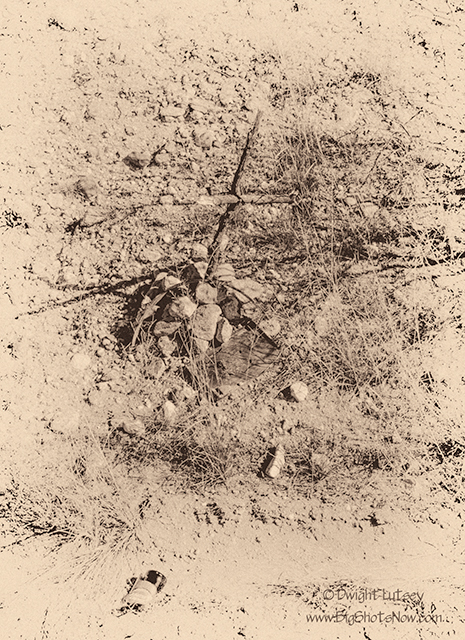
Somewhere south of Socorro they began to appear in profusion, these little roadside crosses. Like mushrooms on a moonlit night they suddenly pushed themselves up into view alongside the endless ribbon of blacktop. Some nestled in amongst the rabbit brush and mesquite, others standing starkly out on the weedless roadside. Some new and shiny, some a little worse for wear, and some of them so old and weather-beaten they barely looked like crosses. These were always the saddest.
No longer standing perfectly upright, but listing in whatever direction the cold New Mexico wind pushed them, they either fell over to lie on the ground, or were kept somewhat upright by the arm of the cross, looking as if they had stumbled and fallen and could barely support themselves, yet resisting the urge to just lie down and be done.
The newest of them had bright vivid plastic flowers in every hue of the rainbow, tied to the cross with twist-ties saved from bread wrappers or more elaborately using green garden tape to hold the larger bunches in place. Huge bouquets of them dwarfing the cross, resembling a small garden which had magically materialized out of the low desert where it couldn’t possibly have grown on its own. Ribbons and bows and extraordinarily beautiful rosaries draped over the crosses, placed there without a thought of their being taken, after all, who would steal from the dead, and if they did they must have needed the salvation far more than the deceased. Many times there would be a picture of a loved one held in an ornate frame or on a rare occurrence a favorite toy, but the one thing they all had in common was they stood there in mute testament to a fallen loved one.
Occasionally there would be an unopened can of beer sitting next to the cross. One doesn’t know what part alcohol played in the need for the cross to appear. For some it had to be the sole reason, for others perhaps it was simply a good memory of better times with friends and companions. It always felt odd seeing that can there. Was it more important to the deceased or the one leaving it?
The crosses themselves were often works of art, rivaling the best tombstones found in any cemetery. One notable one was fashioned out of what appeared to be mesquite wood by an obvious master craftsman. Carefully fitted together, polished to a piano finish and carved with the name “Missy” on it, it was as close to a shrine as you were going to find on that lonely stretch of road. There were fresh footprints around it and surprisingly very little dust on the flowers so it seemed that Missy had recently joined the many lonely inhabitants along the highway.
Ironically several dozen yards down the road from Missy’s cross was another one that was nearly invisible and easily overlooked. It had probably been fairly elaborate too but wasn’t anymore. It lay on its back having toppled over from the small cairn of rocks gathered to hold it upright. Perhaps by the wind or maybe by some errant animal stopping by to check it out. Javelina like to root around and stick their snouts in things. It could have easily pushed it over. If so, any tracks were long gone, the earth around the cross scrubbed clean by the wind and rain and time. It had been carefully but plainly made of wood which had been turned grey by the weather. No sign of any name was visible and there weren’t any flowers or ribbons or rosaries, just the cross, slowly breaking down into the hard packed sand of the roadside. Whoever had taken the effort to erect it hadn’t visited in a very long time. Perhaps they had their own cross somewhere else.
Other crosses weren’t quite so elaborate. They were made of practically anything one could imagine. Bent wire with a plastic bow, simple wooden ones fashioned from two slats nailed together and a name written in black magic marker on it, one made of poured concrete that must have taken several people to stand it in place, a simple wooden plank with a name barely visible scratched onto the surface, while others were obviously purchased somewhere and then embellished later. Many of these were fancy molded plastic with intricate simulated carving and verses from the bible cast onto their surfaces. Pretty, but obviously not made to stand the test of time. Perhaps the mourners thought they would last long enough and chose beauty over substance. Regardless of the material they all had been lovingly handled by whoever selected them.
Sometimes there would be a stretch of highway where several dozen or more crosses would be spaced along the roadway at varying distances, while other times you could drive for miles without seeing one. But you always saw one, sometime. They were as much a part of the scenery as the eroded arroyos and the low purple mountains off in the distance.
It is a strange feeling standing next to one of these crosses, out in the open, out of the safety of your own vehicle, the traffic speeding by at 75 miles an hour, the trucks roaring by in the tornados of their own making, the occasional horn being blown at you to signal that they see you. Strangers hurtling towards their destination with barely a glance at this roadside marker. When there is a lull in the traffic which is seldom, you can feel the silence. The wind brushes by without a sound and the beautiful low lying mountains off towards the horizon are shrouded in a mist that partially obscures them. You can stand very still and see if you feel any presence here, I don’t, but maybe you have to have a different connection with whoever was here.
It made one think about why the need to commemorate the exact spot where this person ceased to be was important. Was the soul of the departed somehow stuck in this place, tethered as it were to this spot where life ended and had to be visited a number of times before it was free to move on? Is that why so many of the crosses were slowly fading away? The person they memorialized with this shrine had finally made that transition and there was no need to continue their upkeep? Obviously these deceased had another resting place where their actual remains were interred, and that was their eternal resting place, yet this spot where one moment they were alive and the next moment they weren’t, is as important to the living as the place in a cemetery where the remains of the departed now rests forever.
I surely don’t have any answers. It’s just what you think about as you drive along this highway of fallen crosses. The scenery is very slow to change in this part of New Mexico, the colors stay the same, the horizon never moves, you’re caught in a kind of time loop where every mile seems exactly the same as the one before it and the only change you get is seeing the next cross along the road. What happened here? Who was this person? Why did they die? Who is the person, or the people, who cared so much for them that they travelled way out here to erect a memorial to them? Why did they stop coming to tend it? Was the one who is gone now, a good person or not? Although this question and its answer no longer matters, what was, was, and its done now. Yet the questions are still never-ending.
So the next time you’re in this part of the country, on this highway somewhere south of Socorro, watch for these small crosses along the roadside. They represent the end of someone’s life, and the love someone had for them. And regardless of who the person was, whether good or bad, important or not, young or old, they were once someone just like you and I, alive, vibrant, and ready to live our lives. May they rest in peace.
Since I thought about and developed this story as I drove the miles between where I am in my own life and my destination, I’ve gone over it a thousand times in my mind. In the descriptions above I’ve made it sound like the entire stretch of the highway was littered with untended markers and that isn’t the way it was. There were stretches where that seemed to be the case and that was what caused the story to generate in my mind, but mostly the memorials were well-tended and looked as if they were visited regularly. That made me think about the part where the remains of the deceased is in their final resting place. Do the visitors who tend these crosses visit both places equally? I have never seen someone actually tending one of these markers or I would stop and ask them that very question. Not out of morbid curiosity but to find out how that actually works. Do they feel that their love for the lost one is received stronger because they make their remembrances in two places?
As a counter-point I have added a few images of these markers where they are obviously well-tended, many of them are dated and show that the site has been cared for and honored, if that is the right word, for many years.
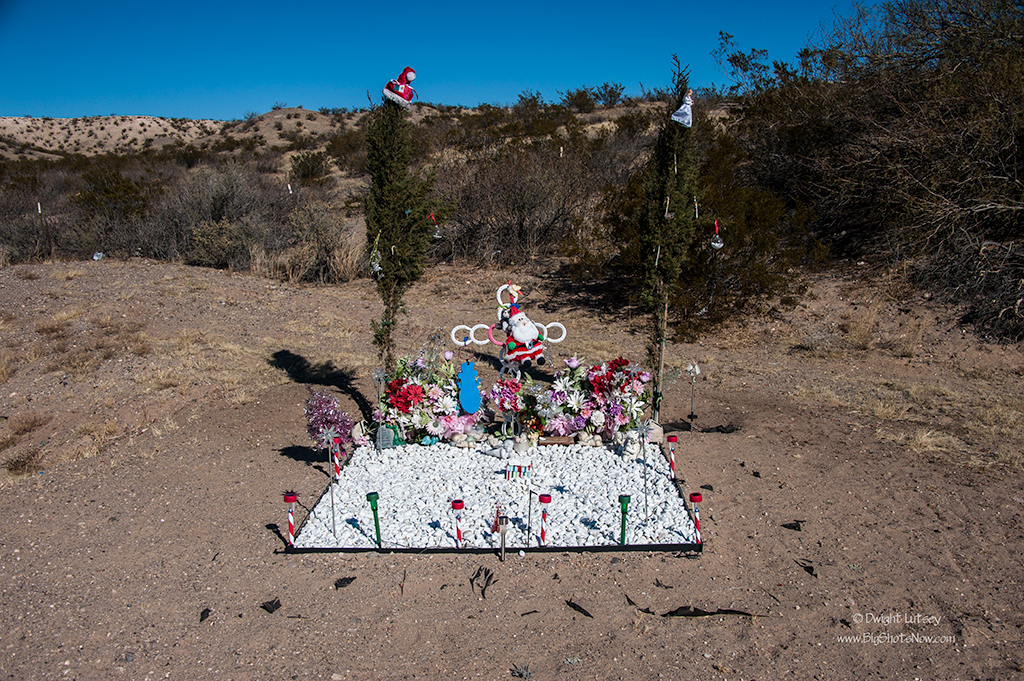
Christmas time is celebrated with all the family whether they’re here in person or not. It’s difficult to get a feeling as to who might be remembered here. Was it a young person? Someone to whom Christmas was very important? Or is it simply a way the remaining family wants to include them in their festivities? The joyous celebration seen here is hard to see as anything but an expression of love and acceptance of their loss.
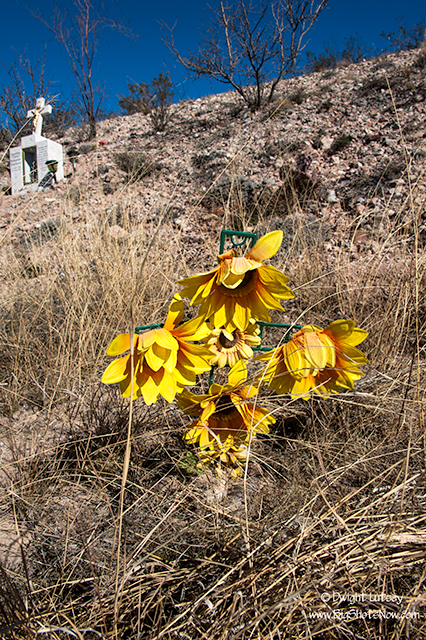
As you can see there are several crosses in this spot. Were they all from the same accident? There are no answers only speculations. They are all remembered each in their own way.
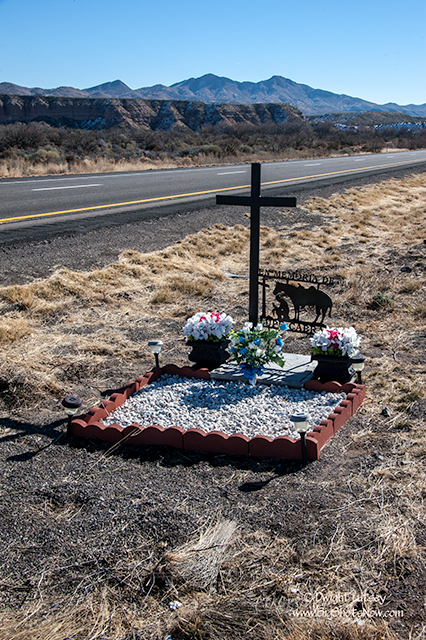
I was always noticing how the plots resembled the shapes of graves in these more elaborate installations. Perhaps there isn’t any other place where this person is memorialized so the more grave-like in appearance it is the more it fulfills the needs of those doing the remembering.

This is the most permanent marker I saw on the trip. It is fashioned out of granite with a niche and statue inside a glass enclosure. The phrase on the right side of the monument begins, if I can trust my rusty Spanish “We know you have gone to join God, it is difficult to accept…..” and then I’m lost. Using translators off the net to help decipher the verse doesn’t help much as there is something stated there upon that granite marker that doesn’t easily translate. I can certainly surmise it expresses grief, longing and love so we’ll leave it at that.
With all due respect to the families and loved ones to whom these memorials belong, I hope that you have found peace with your loss, and know that there are those who do not know you but understand your love for these people who are no longer here but occupy such a huge space in your heart. Although it is unlikely you’ll ever know that these passerby’s recognize your loss, be comforted by the fact that they do. It gives one hope that if they ever have their own cross by the roadside, someone will pass by and recognize that you too, were once here, on this highway of forgotten crosses.

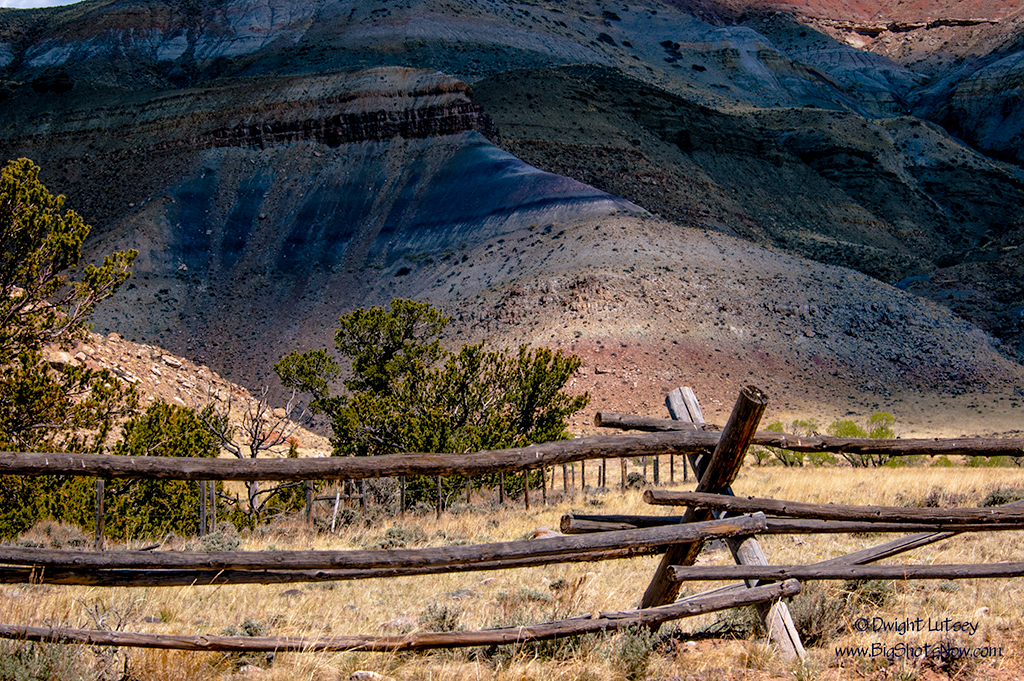
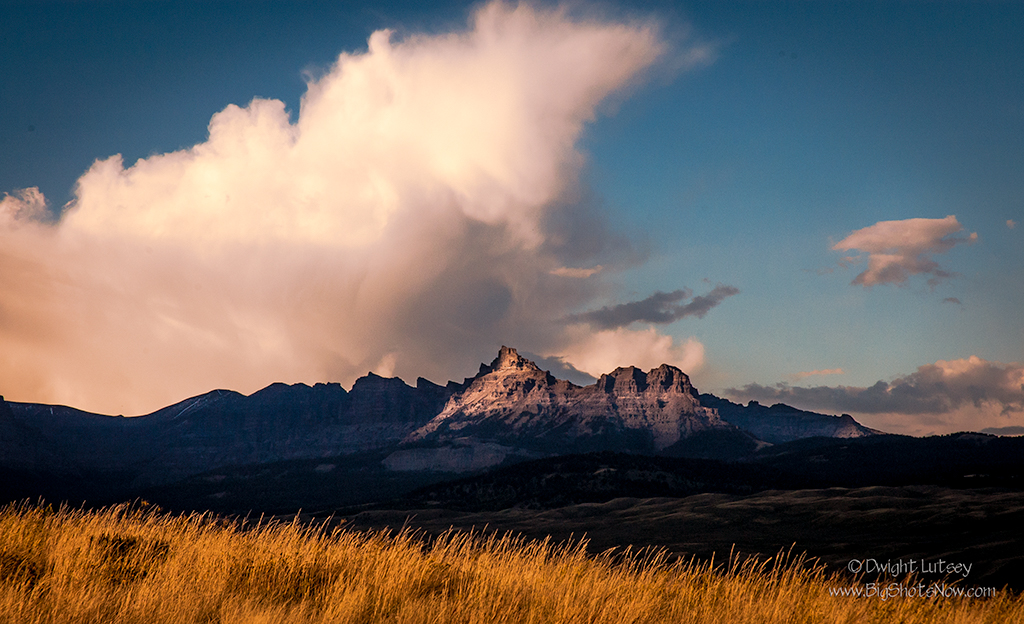
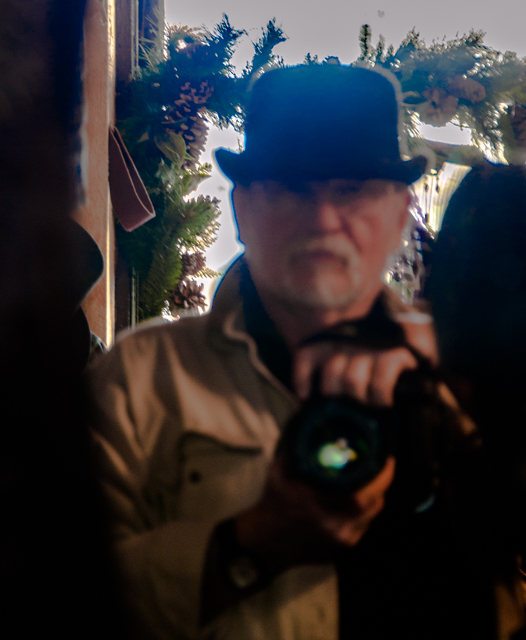





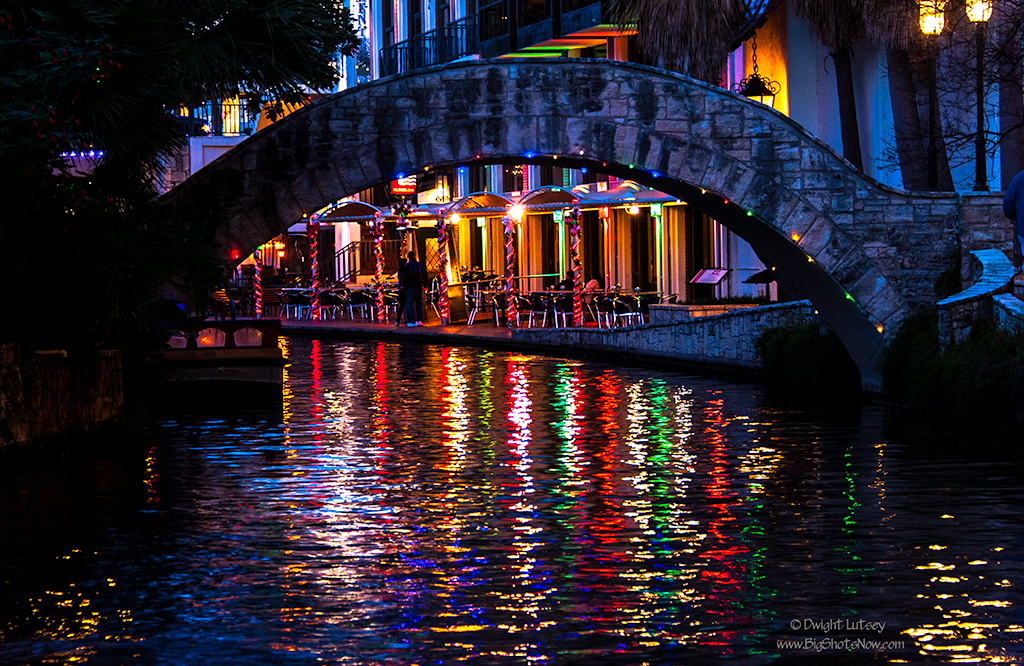
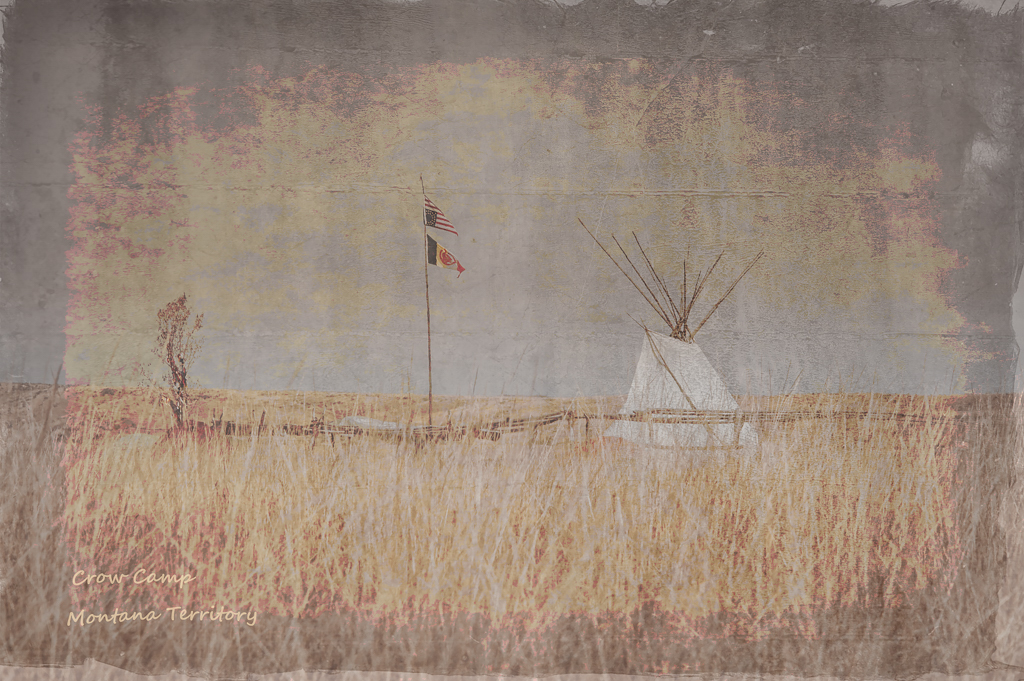
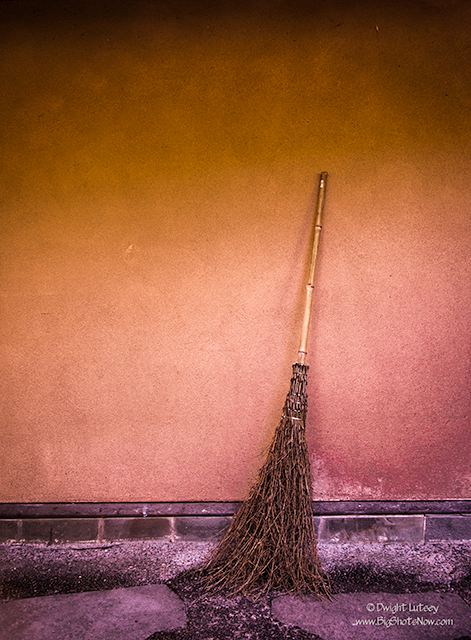
You must be logged in to post a comment.